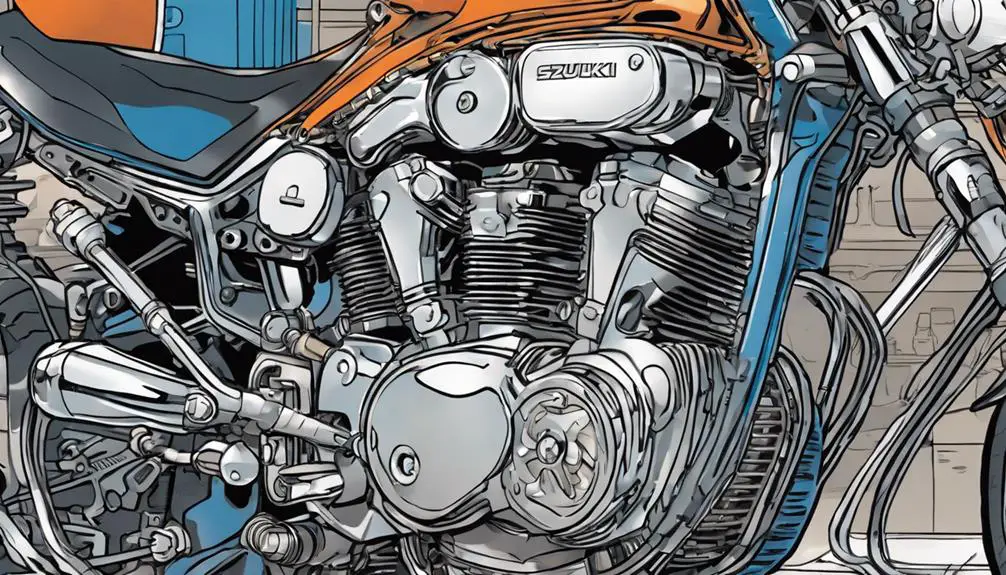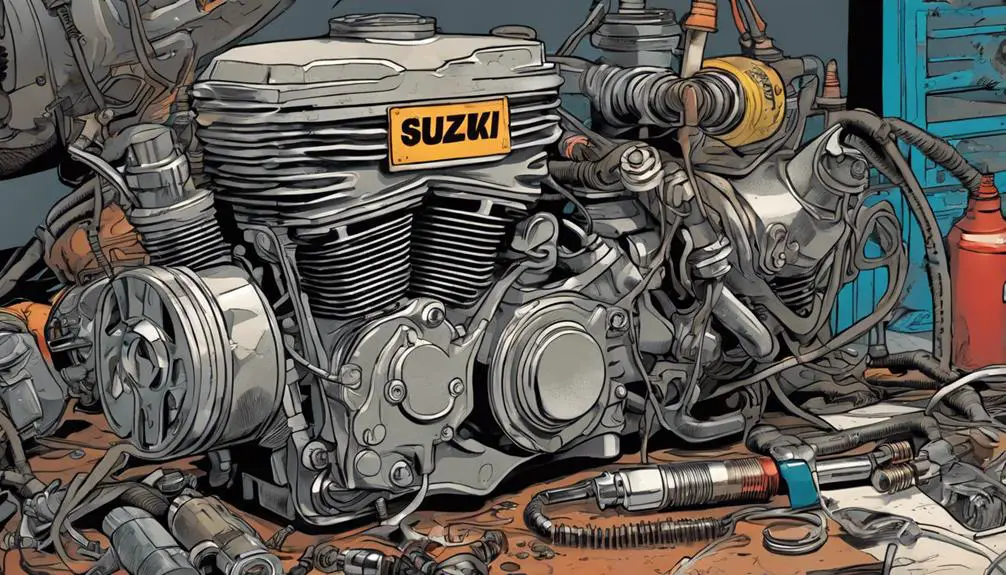When you're examining Suzuki bike engine specs, it's essential to grasp a few key elements that can greatly influence your riding experience. Start by considering engine displacement—larger engines often mean more horsepower, which can enhance performance. Next, think about the compression ratio and cooling system; these can affect both power output and efficiency. Finally, don't overlook the weight-to-power ratio; a lighter bike paired with adequate power can lead to greater agility. But these factors can get complex, so let's break them down further to see how they impact your choice.
Quick Takeaways
- Understand the engine displacement to gauge the bike's power and performance capabilities, as larger displacements often yield higher horsepower.
- Consider the engine type; options like single-cylinder or V-twin affect handling and torque delivery, impacting your riding experience.
- Check the compression ratio; a higher ratio can enhance fuel efficiency and power but may necessitate premium fuel.
- Evaluate the weight-to-power ratio; a lighter bike with sufficient power improves agility, making it easier to maneuver.
Understanding Engine Specifications

When you're looking at Suzuki bike engine specs, it's essential to grasp key details that affect performance and efficiency.
Start by understanding the engine displacement, usually measured in cubic centimeters (cc). This number indicates the size of the engine and typically correlates with power output. A larger displacement often means more horsepower, giving you that exhilarating freedom on the road.
Next, pay attention to the engine type. Whether it's a single-cylinder, parallel-twin, or V-twin, each design influences the bike's handling and torque delivery. For instance, a V-twin might provide a more robust low-end torque, perfect for cruising, while a high-revving inline-four engine can release thrilling acceleration at higher speeds.
Don't overlook the compression ratio, either. This ratio affects how efficiently your engine burns fuel, directly impacting performance and fuel economy. A higher compression ratio generally equates to more power, but it might require premium fuel.
Lastly, familiarize yourself with the cooling system—air-cooled or liquid-cooled—as it plays a significant role in how your engine performs under various conditions.
Understanding these specifications can help you choose a Suzuki bike that truly sets you free on the open road.
Evaluating Performance Data
Understanding how engine specifications translate into real-world performance data is essential to choosing the right Suzuki bike for your riding style.
Start by examining horsepower and torque figures; they reveal how your bike will behave under acceleration and at different speeds. Higher horsepower often means thrilling top speeds, while robust torque translates to powerful low-end performance, ideal for city riding or off-road adventures.
Next, consider the bike's weight-to-power ratio. A lighter bike with sufficient power enhances agility, making it easier for you to navigate tight corners or city traffic.
Don't overlook the bike's gear ratios either; they affect how quickly your bike can accelerate and its overall responsiveness.
Fuel efficiency is another important factor. You want to maximize your freedom on the open road without frequent stops at the pump.
Common Issues to Consider

Before you hit the road, it's important to be aware of common issues that can arise with Suzuki bikes, as they can impact your riding experience.
First, keep an eye on electrical problems. Faulty wiring or a weak battery can leave you stranded, so regularly check connections and charge levels.
Next, listen for unusual sounds from the engine. Knocking or rattling can signal deeper mechanical issues, and ignoring them could lead to costly repairs. Additionally, pay attention to oil leaks; they can affect performance and indicate a serious problem.
Brakes are another significant area. If you notice any decrease in responsiveness, it's time to inspect brake pads and fluid levels.
Common Questions
What Tools Are Needed for Measuring Engine Specs Accurately?
To measure engine specs accurately, you'll need a few essential tools.
Start with a reliable torque wrench to guarantee proper tightness of bolts.
A caliper helps you measure dimensions precisely, while a feeler gauge is great for checking clearances.
Don't forget a compression tester to gauge engine health.
With these tools in hand, you can plunge into your project, gaining the knowledge and freedom to understand your machine better.
How Often Should I Check My Suzuki Bike's Engine Specifications?
You might think checking your engine specifications is a chore, but it's actually a liberation of sorts.
You should check your Suzuki bike's engine specs at least once a month, or before long rides. Regular checks not only guarantee peak performance but also save you from unexpected breakdowns.
Can I Modify My Engine Specs Without Voiding the Warranty?
You can modify your engine specs, but tread carefully.
Check your warranty terms first—many manufacturers have specific clauses that could void it.
If you're looking to enhance performance, consider bolt-on modifications that usually maintain warranty coverage.
Always consult your dealer or a trusted mechanic to clarify what's allowed.
What Are the Best Practices for Maintaining Engine Performance?
Maintaining engine performance isn't just a task; it's like giving your bike a second chance at life!
You've gotta check the oil regularly, keep the air filter clean, and guarantee the fuel system's in top shape.
Don't skip routine maintenance, and always use the right fuel. It's your ticket to releasing your bike's full potential.
Where Can I Find Official Suzuki Engine Specification Documents?
You can find official Suzuki engine specification documents on their website under the 'Support' or 'Resources' section. They often provide downloadable PDFs for specific models.
If you need more detailed information, visiting a local dealership or contacting Suzuki customer service can help.
You'll also find forums and online communities where fellow enthusiasts share insights and documents, fostering a sense of freedom in accessing the knowledge you seek for your bike.
Wrapping Up
In summary, grasping Suzuki bike engine specs is essential for enhancing your riding experience.
Did you know that a bike's weight-to-power ratio can greatly affect acceleration, with lighter models often achieving 0-60 mph in under 4 seconds? This means you can enjoy thrilling rides while handling effortlessly.
By focusing on engine displacement, compression ratios, and overall weight, you're setting yourself up for an exhilarating adventure on two wheels.
Choose wisely, and let the road be your playground!